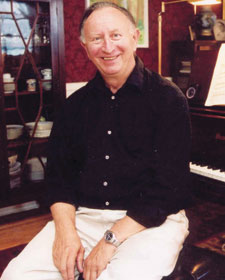|
|
 |
 |
|
AROUND THE QUADSHistory Professor J.W. Smit Dies at 75By Timothy P. Cross ’85 GSAS, ’98 GSAS

Queen Wilhelmina Professor J.W. Smit at his Morningside Drive apartment in 2003. Photo: Michael Dames 
J.W. Smit, the Queen Wilhelmina Professor Emeritus of the History, Language and Literature of the Netherlands and a powerful voice in Columbia’s intellectual life for the past 40 years, died in his home in the Netherlands of an apparent heart attack on July 19. He was 75. Jacobus Wilhelmus “Wim” Smit was born on August 25, 1930, in Utrecht, the Netherlands. His father owned a cigar-making factory; his mother’s family ran local saloons. His mother’s family was devoutly Roman Catholic, and the Friars who ran Smit’s school encouraged his mother to send him to seminary. But World War II interrupted his formal education. During the Nazi occupation, to make ends meet, Smit’s family lived off proceeds from a warehouse of tobacco that his father had hidden. The young Smit and his father would bicycle the tobacco to the countryside, where they would barter with local farmers for food. When Smit’s father died in 1950, Smit became de facto head of the business, though it never fully recovered from the war. He eventually sold the factory and resumed his studies, paying for his education at the University of Utrecht by playing piano in local nightclubs and semi-professional soccer. He studied history (noted historian Pieter Geyl was among his mentors and champions), receiving his master’s in 1953 and doctorate in 1958. He worked at Rabobank until joining the Utrecht faculty, where he taught until 1965, when he came to Columbia. Smit was an authority in the social, religious, cultural and economic history of early modern Europe. He taught upper division courses on historiography, the origins of capitalism, and Dutch art and culture, among others. Although Smit officially retired in 2002, at the time of his death he was preparing a new course, “The Problem of Toleration in 16th- and 17th-Century Europe,” which was to be taught for the first time in fall 2006. As a young professor, Smit achieved a measure of national notoriety for his contributions to left-leaning Dutch publications, including the journal Diatribe, which he co-founded. He published Fruin en de Partijen Tijdens de Republiek in 1958. Although never as prolific in English, Smit wrote a notable essay on the origins of the Dutch Revolt and the early modern Netherlands, as well as “History and Art,” in Art in History, History in Art, Studies in 17th Century Dutch Culture, edited by David Freedberg and Jan de Vries (1991). In addition, he co-authored The Dutch in America, 1609–1970: A Chronology and Fact Book (1972) with his second wife, Pamela Richards. Smit had a remarkable facility with language: in addition to Dutch and English, he was fluent in French, German and Italian; read Latin, Greek, Spanish, Russian and some Chinese; and was learning Arabic. Although Columbia hired Smit to teach in GSAS, he quickly gravitated toward undergraduate teaching as well, especially in the Core Curriculum. He began teaching “Introduction to Contemporary Civilization” in the early 1970s and twice (1978–82, 1989–92) served as chair of the course. He served on the Commission on the Core Curriculum (1988–89), and when the commission successfully advocated for the creation of a Standing Committee on the Core, Smit became its first chair. Smit’s long association with the Contemporary Civilization course seemed to whet his interest in Columbia’s other Core courses. An expert on Dutch art, he began teaching Art Humanities in the early 1990s. He turned his love of the piano into teaching Music Humanities, as well. And remarkably, in the last few years, he began teaching Literature Humanities. Smit thus came to be the first teacher to have taught all four Core courses in the nearly 60 years that they have been essential elements of the College’s undergraduate curriculum. Both graduate students and undergraduates laid claim to Smit. He supervised dozens of theses and dissertations, and he became a friend and mentor to countless graduate students who got their first experience in teaching as preceptors in the Core Curriculum. He routinely invited students to his apartment on Morningside Drive to discuss their work or to enjoy his famous Indonesian Rijstafel. He was no less popular with undergraduates. He received the Mark Van Doren Award for Great Teaching from the Columbia College Student Council (1984), was a co-recipient (with Professor of English James Mirollo) of the first award for Distinguished Service to the Core Curriculum (1993), and received a special award for service to Columbia from the Society of Columbia Graduates (2004). Smit’s first marriage, to Hans Payens, ended in divorce. His second wife, Richards, died in 1999. Smit is survived by his children, Tijn, Michiel, Guy and Marijke ’94; two grandchildren, Aims and Cobus; and his brother, Johan. A memorial service was held on campus on September 18. The family has created a website (www.jwsmit.com), where friends can post and read reminiscences
|
|
||||||||||||||||||||||||||||




